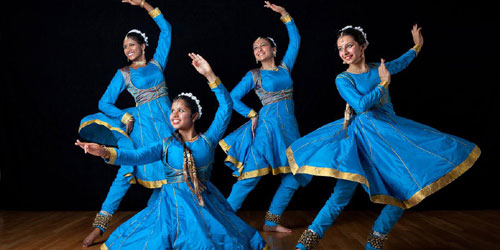Kathak is one of the important dance forms of India. Kathak has been derived from the word Katha, which means storytelling. This form of dance was originated in northern India. It is very similar to Bharatnatyam dance form. Kathak traces its origin to the nomadic bards of ancient northern India. These bards were also called Kathakars. They used to recite religious and mythological tales to the accompaniment music mime and dance. Today its form contains traces of temple and ritual dances. It also has on it influences of the Bhakti Movement.
This dance form assumed the form of courtly entertainment under the influence of Persian and Muslim traditions. Some medieval rulers and Nawabs provided patronage to Kathak dancers. Medieval traditions imparted Kathak a specific Hindu-Muslim texture. This dance form went on changing its form and character with the passage of time. Not only the form but also the dress of the Kathak dancers showed changes.
Read Also: Kathakali Indian Dance Drama
Many emperors and princely states contributed in the growth and development of this form of dance into different gharanas.These gharans were named after the cities in which they were involved. Each gharana has its particular style. The different gharanas of Kathak are:
Jaipur Gharana: It developed in the courts of Kanchwaha kings of Jaipur in Rajasthan. In this style, the importance is placed on the more technical aspects of dance, such as complex and powerful footwork, multiple spins, and complicated compositions in different talas. In this style, there is a lot of usage of compositions from the pakhawaj such as parans.
Must Read: Indian classical dance forms Bharatanatyam, Kuchipudi, Kathakali, Odissi
Lucknow Gharana: It came into existence mainly in the court of Wajid Ali Shah, the Nawab of Oudh. This gharana or style Kathak emphasized dramatic and sensuous expression. The Lucknow gharana of Kathak attained maturity , through the efforts of Thakur Prasad Maharaj, the court dancer and guru of Nawab Wajid Ali Shah. Presently , Birju Maharaj is considered the chief representative of this gharana.
Benares Gharana: This style or form was developed by Janakiprasad. The characteristic features of this style or gharana is the exclusive use of the natwari or dance bols. They are different from the table and pakhawaj bols. There is also the greater use of the stage.
Also Read: Classical Dances of India: Mirror of Cultural India
Raigarh Gharana: This style was established by the Maharaja Chakradhar Singh in the princely state of Raigarh. The Maharaja invited many expert Kathak dancers as a well as famous percussionists to his court. The confluence of different styles and artistes created a unique environment for the development of Kathak and table compositions. Some of the renowned dancers of this form are Late Pt. Kartik , Late Pt. Kalayandas Mahant, Dr. Rakhi Dubey, Vaasanti Vaishali, Annapurna Sharma, ec.
This form of dances are performed straight-legged and the ankle bells worn by the dancers. The more emphasis is more on footwork unlike hasta mudras or hand formations in Bharatnatyam dance. All compositions are so performed that the final step and beat of the composition lands on the sam meaning even or equal. Almost all the compositions also have ‘bols’ (rhythmic words). The recitation of these bols forms an integral part of the performance. Kathak dance can be performed by both men and women. In Kathak the dancer is not required strictly to stick to fixed steps and stages. He or she can change the sequence of steps to suit his or her skill and style of dancing. Birju Maharaj and Uma Sharma are modern exponents of Kathak dance.
Don’t Miss:



Thank you sir.